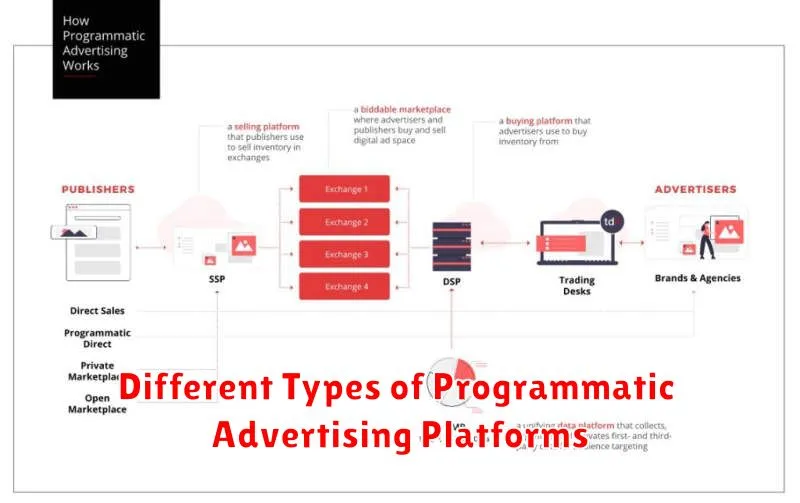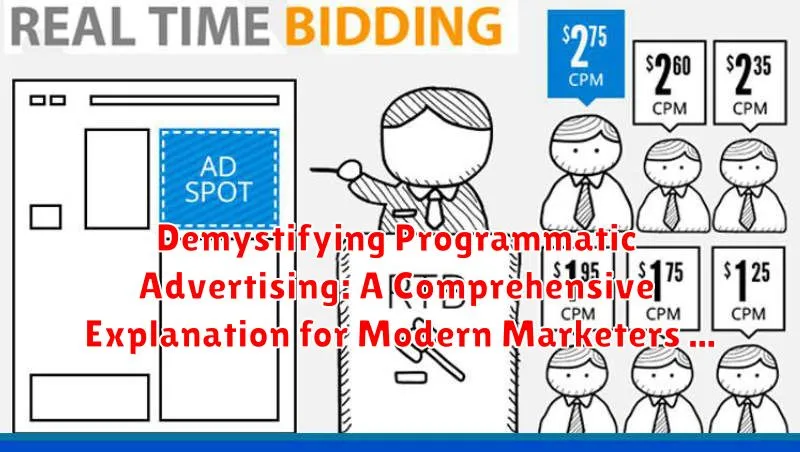Welcome to the world of programmatic advertising! In today’s rapidly evolving digital landscape, understanding programmatic advertising is no longer a luxury, but a necessity for modern marketers. This comprehensive guide, “Demystifying Programmatic Advertising: A Comprehensive Explanation for Modern Marketers,” serves as your essential resource for navigating this complex yet powerful marketing strategy. We will break down the core concepts, explore the various facets of programmatic, and empower you with the knowledge needed to effectively leverage its potential to reach your target audience and achieve your marketing objectives.
This article will delve into the mechanics of programmatic advertising, exploring how it automates the buying and selling of digital ad space. We will demystify key terms such as real-time bidding (RTB), demand-side platforms (DSPs), and supply-side platforms (SSPs). By understanding these fundamental elements, you’ll gain a clear picture of how programmatic allows marketers to target specific demographics, interests, and behaviors with unparalleled precision, ultimately optimizing ad spend and maximizing return on investment. Join us as we unlock the secrets to successful programmatic advertising campaigns and help you gain a competitive edge in the digital marketplace.
What is Programmatic Advertising and How Does it Work?
Programmatic advertising is the automated buying and selling of digital advertising space in real time. Unlike traditional methods that involve manual negotiation and insertion orders, programmatic relies on algorithms and software to streamline the process.
At its core, programmatic advertising works by connecting advertisers with publishers through a technology platform. When a user visits a website or app, information about that user and the available ad space is sent to the platform. Advertisers then bid on the opportunity to show their ad to that specific user. The winning bid results in the ad being displayed. All of this happens in milliseconds.
Key steps in the process:
- User visits a website.
- Information is sent to the ad exchange.
- Advertisers bid on the ad space.
- The winning ad is displayed to the user.
This automated process allows for more efficient and targeted advertising campaigns.
The Key Components of the Programmatic Ecosystem
The programmatic advertising ecosystem comprises several interconnected components that facilitate the automated buying and selling of digital ad space. Understanding these components is crucial for marketers seeking to leverage programmatic effectively.
Demand-Side Platform (DSP): A DSP is a technology platform used by advertisers to buy ad impressions across a range of publisher sites. DSPs allow advertisers to set targeting parameters, bid on impressions in real-time, and optimize campaigns.
Supply-Side Platform (SSP): SSPs are used by publishers to manage and sell their ad inventory programmatically. SSPs connect publishers to multiple ad exchanges and DSPs, maximizing revenue opportunities.
Ad Exchange: An ad exchange is a digital marketplace that facilitates the buying and selling of ad space between DSPs and SSPs through real-time auctions.
Data Management Platform (DMP): A DMP is a centralized data warehouse that stores and manages audience data from various sources. DMPs enable advertisers to enhance targeting and personalization efforts within programmatic campaigns.
Ad Server: An ad server hosts and delivers ads to websites and apps. It tracks ad performance metrics such as impressions, clicks, and conversions.
Benefits of Programmatic Advertising over Traditional Methods
Programmatic advertising offers significant advantages over traditional advertising methods, primarily in terms of efficiency, targeting, and cost-effectiveness.
One key benefit is enhanced targeting capabilities. Traditional advertising often relies on broad demographics, while programmatic allows for precise targeting based on user behavior, interests, and online activities. This results in more relevant ads being displayed to the right audience.
Furthermore, programmatic advertising automates the buying and selling of ad space, streamlining the process and reducing manual labor. This leads to greater efficiency and allows marketers to focus on strategy and optimization.
Another significant advantage is real-time optimization. Programmatic platforms provide data-driven insights, allowing marketers to monitor campaign performance and make adjustments on the fly. This iterative approach ensures that campaigns are continuously improved for maximum ROI.
Understanding Real-Time Bidding (RTB) and Programmatic Direct
Within the landscape of programmatic advertising, two primary methods of execution stand out: Real-Time Bidding (RTB) and Programmatic Direct. Understanding the nuances of each is crucial for effective campaign strategy.
Real-Time Bidding (RTB) is an auction-based system where ad impressions are bought and sold in real-time. Advertisers bid on individual impressions based on factors like user data and website context. The highest bidder wins the auction and their ad is displayed.
In contrast, Programmatic Direct, also known as programmatic guaranteed, involves direct negotiations between advertisers and publishers. Inventory and pricing are pre-negotiated, offering advertisers more control over ad placement and guaranteed impression volume.
Here’s a brief comparison:
- RTB: Auction-based, real-time, focuses on efficiency and reach.
- Programmatic Direct: Negotiation-based, guaranteed inventory, focuses on premium placements.
The choice between RTB and Programmatic Direct depends on campaign objectives, budget, and desired level of control.
Different Types of Programmatic Advertising Platforms

The programmatic advertising landscape is populated by various platforms, each serving specific functions and catering to different needs. Understanding these platforms is crucial for effective campaign management.
Demand-Side Platforms (DSPs)
DSPs allow advertisers to buy ad space across a range of publishers and ad networks. They provide tools for targeting, bidding, and campaign optimization. Key features include real-time bidding (RTB) capabilities and integration with data management platforms (DMPs).
Supply-Side Platforms (SSPs)
SSPs are used by publishers to manage and sell their ad inventory. They connect publishers to multiple ad exchanges and DSPs, maximizing revenue and controlling pricing. Features include yield optimization and inventory management.
Ad Exchanges
Ad Exchanges are digital marketplaces where DSPs and SSPs connect to buy and sell ad space. They facilitate real-time bidding and automated ad transactions. They provide a central hub for programmatic advertising.
Data Management Platforms (DMPs)
While not strictly advertising platforms, DMPs are vital for programmatic advertising. They collect and organize data from various sources, enabling advertisers to target specific audiences with greater precision. DMPs provide the data backbone for personalized advertising.
Targeting Options Available in Programmatic Advertising
Programmatic advertising offers a granular approach to reaching specific audiences. Advertisers can leverage a wealth of data to precisely target their desired customers, improving campaign effectiveness and ROI. The options include:
- Demographic Targeting: Reaching users based on age, gender, income, education, and occupation.
- Geographic Targeting: Focusing on specific locations, from countries and regions to cities and postal codes.
- Behavioral Targeting: Targeting users based on their online activities, interests, and purchase history. This often involves tracking cookies and website visits.
- Contextual Targeting: Displaying ads on websites and content that are relevant to the product or service being advertised.
- Retargeting: Showing ads to users who have previously interacted with your website or ads.
- Technology Targeting: Targeting users based on the devices, operating systems, and browsers they use.
- Lookalike Modeling: Identifying new potential customers who share similar characteristics with your existing customer base.
By combining these targeting options, advertisers can create highly specific audience segments and deliver personalized messages, leading to improved campaign performance.
Measuring and Optimizing Programmatic Campaigns for ROI
Measuring and optimizing programmatic campaigns are crucial for demonstrating return on investment (ROI). This involves tracking key performance indicators (KPIs) and making data-driven adjustments to improve campaign performance.
Key Performance Indicators (KPIs)
- Click-Through Rate (CTR): Measures the percentage of impressions that result in clicks.
- Conversion Rate: Tracks the percentage of clicks that lead to desired actions (e.g., purchases, sign-ups).
- Cost Per Acquisition (CPA): Calculates the cost of acquiring a customer.
- Return on Ad Spend (ROAS): Measures the revenue generated for every dollar spent on advertising.
Optimization Strategies
Regularly analyze campaign data to identify areas for improvement. This may involve adjusting targeting parameters, ad creative, or bidding strategies. A/B testing different ad variations can also help optimize for better performance.
Continuously monitor campaign performance and make adjustments as needed to maximize ROI.
The Role of Data in Programmatic Advertising
Data is the lifeblood of programmatic advertising. It fuels the entire process, enabling marketers to target the right audience, with the right message, at the right time. Without data, programmatic advertising would simply be automated guesswork.
First-party data, collected directly from a brand’s own sources (e.g., website visits, customer purchases), is invaluable for creating highly targeted campaigns. This data offers insights into customer behavior and preferences.
Second-party data, which is another company’s first-party data, can be acquired through partnerships and provides access to a wider range of audience information. This is normally a win-win relationship of both parties.
Third-party data, aggregated from various sources, offers broad demographic and behavioral insights. Though widely accessible, its accuracy and relevance should be carefully evaluated. It offers the scale needed for larger campaigns.
By leveraging these data sources, marketers can build detailed audience segments, personalize ad creatives, and optimize campaigns in real-time to maximize return on investment (ROI).
Challenges and Considerations in Programmatic Advertising
While programmatic advertising offers numerous advantages, it also presents several challenges that marketers must address to ensure campaign success. One primary concern is brand safety. Advertisements may inadvertently appear alongside inappropriate or offensive content, potentially damaging brand reputation. Careful monitoring and whitelisting of reputable publishers are essential.
Data privacy is another significant consideration. Compliance with regulations like GDPR and CCPA requires marketers to handle user data responsibly and transparently. Ensuring data security and obtaining proper consent are crucial.
Ad fraud remains a persistent issue in the programmatic landscape. Invalid traffic, bot clicks, and domain spoofing can inflate campaign metrics and waste advertising spend. Implementing fraud detection tools and working with trusted partners can help mitigate this risk.
Finally, the complexity of programmatic platforms and algorithms can be daunting. A thorough understanding of the technology and a commitment to continuous learning are necessary to effectively manage and optimize programmatic campaigns.
The Future of Programmatic Advertising and Emerging Trends

The landscape of programmatic advertising is constantly evolving, driven by technological advancements and shifting consumer behaviors. Staying ahead requires understanding the key trends shaping its future.
Key Trends to Watch
- AI and Machine Learning Enhancement: Expect more sophisticated algorithms for predictive targeting, creative optimization, and fraud detection.
- Increased Focus on Privacy: With growing privacy concerns, programmatic will adapt through solutions like differential privacy and anonymized datasets.
- Expansion of Channels: Programmatic is moving beyond display and video to encompass channels like Connected TV (CTV), digital out-of-home (DOOH), and audio.
- Emphasis on Transparency and Brand Safety: Advertisers will demand greater transparency in the supply chain and robust measures to protect brand reputation.
- The Rise of Identity Solutions: As third-party cookies depreciate, expect increased adoption of alternative identity solutions and contextual targeting.
These emerging trends promise a more efficient, effective, and responsible future for programmatic advertising. Marketers who embrace these changes will be best positioned to succeed.

